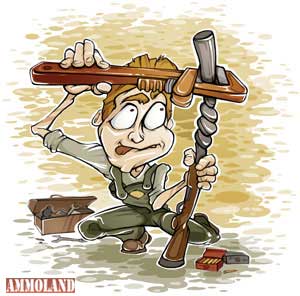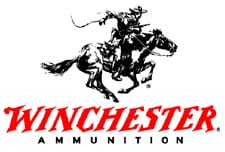By Michael Turbyfill

East Alton, IL – -(Ammoland.com)- In today’s fast-paced world, an answer to almost any question can be found with a quick Google search.
There are millions of myths, rumors, and lots of downright bull floating around when it comes to ammunition, firearms, hunting, and shooting. Lucky for you, you’re about to get the whole truth and nothing but the truth, on a few select topics. Where I’m from, we call this getting “slapped upside the head with some knowledge”.
So either get ready–or else, now is a good time to duck.
Shooting Uphill & Downhill
Shooting uphill and shooting downhill, with a rifle, are two practices that have confused hunters for years. Between distance, slope, gravity and wind, it’s rocket science, right? Not so fast it’s actually much simpler than you think.
Remember this for a rule of thumb: a rifle that is zeroed in at a level distance will shoot higher when shooting uphill and downhill at the same distance. This effect grows larger as the slant range distance grows longer and the elevation angle grows steeper. So remember, if you are shooting on a steep uphill or downhill, hold low. Another point to remember is that headwinds will cause a bullet to drop more and tailwinds will cause a bullet to drop less regardless of an uphill or downhill shot.
What Size Shot Is Most Effective For Turkeys?
Turkey hunters are a passionate bunch. If you get a bunch of turkey hunters around a campfire, you’re likely in for a heated debate. Get it? Campfire = HEATED debate. Funny campfire joke or not, turkey hunters argue about everything under the sun. What brand or pattern of camo is best? What type of turkey call is most effective? What locator call causes an ol’ gobbler to sound off every time?
One of the more popular subjects up for debate is what size shot works best for bagging a big bird? States have different laws for what to use for turkeys, but the most popular shot sizes are #4s, #5s and #6s. The fact of the matter is that all three have their appropriate time and place in the spring turkey woods.
Generally, #6s will provide the densest, most impressive patterns at the range. For field hunting, where leaves, limbs, stumps and tree trunks can’t blow a pattern, #6s are tough to beat. For hunting in thicker, wooded areas, a hunter may be better off choosing #4s.
One consideration is downrange energy. Larger pellets better maintain their energy at farther distances than smaller shot sizes. Winchester agrees with the National Wild Turkey Federation’s recommendation that turkey hunters limit their shots to 40 yards or less. However, hunters inevitably choose to push the limits of their equipment.
With that said, #4 pellets carry higher energy levels than #6 pellets at longer distances.
A happy medium is #5 pellets. They have an increased pellet count and generally denser pattern than #4s and maintain energy farther downrange than #6s.

Barrel Twist
Rifle barrel twists are standardized based on calibers and chosen by the rifle manufacturer to optimize the performance of bullet weights in each caliber. For example, all .300 WSM rifles have a 1:10 twist because that rate is good for stabilizing the various bullet weights at velocities that .300 WSM offers.
Currently, a hot topic of discussion among modern sporting rifle (MSR) enthusiasts is the twist rate on .223 Rem. and 5.56mm rifles. A faster twist rate is needed to stabilize a heavier and/or longer bullet. The advantage in going with a faster twist rate in an MSR is that it gives you flexibility to shoot heavier bullets accurately. However, faster is not always better. The disadvantage is that some lighter-weight bullets can’t maintain integrity upon leaving a barrel with a fast twist rate.
If you’re in doubt with what twist rate to go with in an MSR, refer to the manufacturer’s recommended twist rates for their products.
Hex Shot Vs. Round Shot
Last year Winchester revolutionized ammunition engineering by launching Blind Side waterfowl ammunition. Blind Side shells are loaded with 100-percent HEX Shot – hexahedron pellets that are cube-shaped. With the launch of Blind Side, the debate continued what are the advantages of hunting with HEX Shot?
Winchester engineers spent years perfecting and refining round shot for shotgun ammunition. Round shot patterns tightly, produces few “flyers” and generally results in consistent patterns.
HEX Shot took the traditional round shot to the next level. HEX Shot “stacks” inside the shell allowing up to 15 percent more pellets to fit in the space normally occupied by 1¼ oz. The cube-shaped pellets hit waterfowl like high-velocity, tumbling bricks. The edges on each pellet produce wider wound channels, creating more trauma on the duck or goose.
Combined with the innovative Diamond Cut Wad, HEX Shot pellets pattern uniformly and respond well to choke tubes, meaning more successful hunts for waterfowl hunters who choose Blind Side.
As for the debate between round vs. non-round shot, Winchester is confident that Blind Side is the best waterfowl load that the company has ever produced. If a box has a horse and rider logo and the legendary Winchester name, you can bet it will perform as designed – it’s just that Blind Side has blazed its own trail as the most innovative and effective waterfowl load in Winchester history.
Lubalox Coating
Winchester offers several awesome cartridges with Lubalox coating– an oxidation process for the jacket that greatly reduces friction within the barrel. Unfortunately, rumors have surfaced that Lubalox coating causes barrel fouling. Nothing could be further from the truth. No special cleaning practices are necessary after firing bullets with a Lubalox coating. In fact, some of Winchester’s most popular cartridges, such as Ballistic Silvertip, E-Tip and XP3, come with this cutting-edge treatment. The coating can help velocity and accuracy, as well as combat pressure spikes. Lubalox is often confused with moly coating, which was popular many years ago. Both Lubalox and moly coatings are black in color, but they are two completely different technologies.
Hi-Speed Camera And Gel Testing For Ammunition
Before hi-speed video testing, ammunition designers and engineers had two points they could reference for data: Point A, where a bullet impacted a target, and Point B, where a bullet stopped in a target. By incorporating hi-speed video recording with gel testing, engineers can now capture the flight, impact, temporary wound channel and stopping point of a bullet in super slow motion. Bullet behavior and wound channels can then be analyzed between Point A and Point B.
This helps during the design process as engineers determine what applications are most suitable for a bullet based on the bullet’s performance both on camera and in ballistic gel.
Think about it: the .223 is a great round for hog hunting and personal defense, but each application requires a different bullet behavior. For hogs, you need slower expansion for deep penetration through thick hide and bone like you get with Razorback XT. For personal defense you need a bullet that expands rapidly and won’t penetrate deeply like PDX1 Defender. By watching a bullet create a wound channel in super-slow motion in gelatin, engineers see exactly how a bullet will behave upon impact.
Ballistic gelatin levels the playing field for each bullet test because it’s consistent, giving engineers a standardized test for products, and it’s accepted by the industry as a simulant of animal tissue.

Drylok System
Have you ever been waterfowl hunting and it’s taken you a few misses to get “warmed up” but once you get a correct lead figured out, you begin hitting everything that flies by?
Part of that is your skill, but another part of it can be attributed to the velocity at which the shot leaves your barrel. Consistent velocities mean that if ducks are all flying the same general speed, you can lead each flying duck by the same amount and hit the duck, time after time.
If the velocities are inconsistent, you’ll be stuck trying to figure out why you’re shooting consistently inconsistent. Get it? The most common thing to mess up your shotshell velocity is damp or wet powder. If this happens, shot pellets that should fire at say, 1,300 fps, may only travel at 1,100 fps and you could miss.
Winchester has solved the damp powder problem for waterfowlers with the patented Drylok system and lacquered primer. Moisture is sealed out from the powder compartment with the Drylok powder cup and the hull with the lacquered primer.
This gives you bone dry powder, shot after shot – even if you drop your shells in the bottom of your boat.
Recoil
From air guns to magnums, if it goes “bang,” then according to the laws of physics, there will be recoil – no matter how much or how little you feel. Recoil is perhaps the first challenge you must learn to deal with as a first-time shooter. So what does the average Joe need to know? Well, everyone should know that felt recoil comes from several factors: shell or cartridge, gun fit, gun design, action type, and user technique. For the purposes of this article, we’re going to stick to ammunition and how it affects recoil.
To understand how ammo contributes to recoil, the most important number to note is the muzzle velocity and the bullet weight of a cartridge. In comparing two cartridges with equal bullet weights, recoil will be higher for the cartridge with higher velocity. For equal velocities, recoil will be greater for the cartridge with a heavier bullet weight.
Be sure to visit Winchester.com and visit the ‘Live the Legends’ blog to keep up with all things Winchester – including new product information, events, hunting stories, images, videos and more.
About Winchester Ammunition
With a company heritage dating back to 1866, Winchester Ammunition was there for the taming of the American West, the Allied Forces’ victory in World War II and through the years, millions of fond memories made in the great outdoors. Known as The American Legend, Winchester is a global leader in sporting, law enforcement, military and personal defense ammunition production. Winchester continues to raise the bar with new products like Blind Side® waterfowl and PDX1 Defender personal defense ammunition. For more, visit Winchester.com.
Images: Ryan Kirby www.ryankirbyillustration.com

